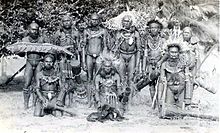- Marind people
-
Marind-anim Regions with significant populations Southern coast of Papua Province, Indonesia. Also known as West Papua Languages Marind Family of the Trans–New Guinea Phylum of Papuan languages
Religion Indigenous beliefs, Christianity
Related ethnic groups Indigenous Papuan peoples of West Papua and Papua New Guinea, other Melanesians
Marind-anim are a people living in South New Guinea, south of the lower parts of river Digul, east of Yos Sudarso Island, mainly west of Maro River (a small area goes beyond Maro at its lower part, including Merauke).[1] Today the area inhabited by Marind-anim is contained by Papua province of Indonesia.
In the past, they were famed because of headhunting.[2] This was rooted in their belief system and linked to the name-giving of the newborn.[3] The skull was believed to contain a mana-like force.[4][5] Headhunting was not motivated primarily by cannibalism, but the already killed person's flesh was consumed.[6]
The people lived spread in several extended families. Such an extended family derives its origin up to a mythological ancestor. Ancestor veneration has a characteristic form here: these mythological ancestors are demon-like figures, they feature in myths, and act as culture heroes, arranging the ancient world to its recent state, introducing plants, animals, cultural goods.[7] They have often the form of plants or animals, there is a kind of totemism, but it is not accompanied by a regular food taboo of the respective animal or plant.[6] Totems can appear both in artefacts[8] and myths.[9]
The word for such an ancestral spirit being is dema in the Marind languages. The material similarity of this word to “demon” is incidental. Each extended family keeps and transfers the tradition, it is especially the chore of the big men of the respective family. The influence of these big men does not go beyond their extended family.[7]
The Marind-anim are also notable for their sexual culture, centered around a cult of male homosexuality. In the century or so before European contact, young Marind-anim men were led through initiatory rituals involving their participation as passive partners in an orgiastic sodomy cult. Ritual intercourse with women effectively constituted a form of collective sexual assault, with marriage commencing with the gang rape of the bride by the husband's male kin. The sexual practices of the Marind-anim exacerbated the threat of demographic collapse imposed by a high rate of infertility, and the Marind-anim consequently maintained their population by capturing children in head-hunting raids.[10]
Their culture was researched by several ethnologists, for example the Swiss Paul Wirz, the German Hans Nevermann,[11] and the Dutch cultural anthropologist Jan van Baal, who was the Governor of Netherlands New Guinea from 1953 until 1958.[12]
The Marind languages form a small family of the Trans–New Guinea language phylum.[13]
Contents
See also
- Dugout (boat)
- Asmat people
- Sago
- Papuan people
- Papuan mythology
- Swamp
- Digging stick
- Hourglass drum
- Secret society
Notes
- ^ Nevermann 1957: 225
- ^ Nevermann 1957: 9
- ^ Nevermann 1957: 111
- ^ Nevermann 1957: blurb
- ^ Nevermann 1957: 112
- ^ a b Nevermann 1957: 13
- ^ a b Nevermann 1957: 12
- ^ Unknown photographer 1920s (see postcard image online)
- ^ Nevermann 1957: 86, 202/note 108 (= Die Taube und die Enten)
- ^ Keesing, Roger M. & Strathern, Andrew J. (1998), Cultural Anthropology: A Contemporary Perspective, 3rd. edition, p. 120
- ^ Nevermann 1957: 7
- ^ Van Baal 1966. A comprehensive standard work on Marind-anim culture.
- ^ Baal 2007: Marind-anim, Orientation (see online)
References
- Van Baal, Jan (1966). Dema. Description and Analysis of Marind-Anim Culture (South New Guinea). The Hague: Martinus Nijhoff.
- Van Baal, Jan (2007). "Marind-anim". World Culture Encyclopedia. Advameg Inc. http://www.everyculture.com/Oceania/Marind-anim.html.
- Nevermann, Hans (1957) (in German). Söhne des tötenden Vaters. Dämonen- und Kopfjägergeschichten aus Neu-Guinea. Das Gesicht der Völker. Eisenach • Kassel: Erich Röth-Verlag. The title means Sons of the killing father. Stories about demons and headhunting, recorded in New Guinea.
- Unknown photographer (cca 1920s). "Marind-Anim men dressed for ceremony, south coast Dutch New Guinea". Old photographs (postcard). Oceania Ethnographica. http://www.oceania-ethnographica.com/mel126.html. A fabulous image of warriors with their drums; the man on the left holds an extremely rare type of carved wooden fish totem.
External links
- Text
- Baal, J. van (2007). "Marind-anim". World Culture Encyclopedia. Advameg Inc. http://www.everyculture.com/Oceania/Marind-anim.html.
- Overweel, Jeroen A.. "The Marind in a Changing Environment. A study on social-economic change in Marind society to assist in the formulation of a long term strategy for the Foundation for Social, Economic and Environmental Development (YAPSEL)" (PDF). Merauke. http://www.hapin.nl/files/pdf/TheMarindinaChangingEnvironment.pdf.
- Marind-anim mythology
- Image
- Unknown photographer (cca 1920s). "Marind-Anim men dressed for ceremony, south coast Dutch New Guinea". Old photographs (postcard). Oceania Ethnographica. http://www.oceania-ethnographica.com/mel126.html. A fabulous image of warriors with their drums; the man on the left holds an extremely rare type of carved wooden fish totem.
Categories:- Indigenous ethnic groups in Western New Guinea
- Tribal societies that have practiced cannibalism
Wikimedia Foundation. 2010.

